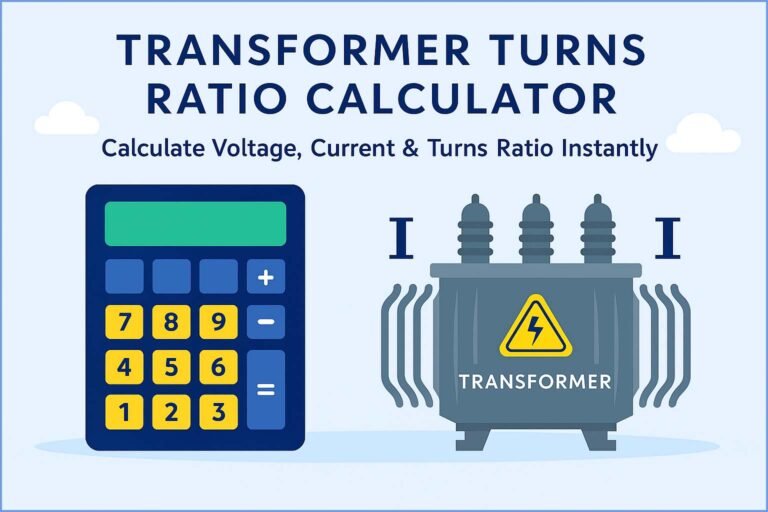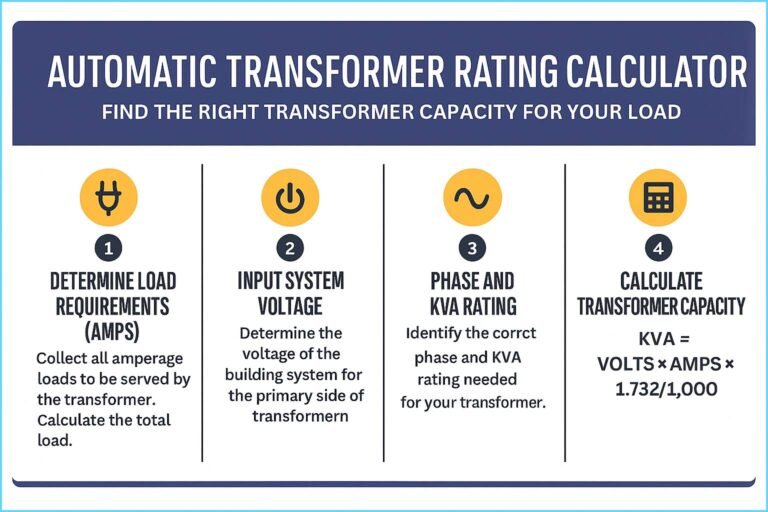Cable Bending Radius Calculator UK – Accurate Tool for Safe Cable Installation
When installing electrical cables, understanding the bending radius is essential. The bending radius determines how tightly a cable can be bent without damaging its insulation or conductors. In the UK, electricians and engineers use the Cable Bending Radius Calculator UK to find the correct radius for safe installations according to BS and IEC standards. This tool ensures cables perform reliably, reduce mechanical stress, and meet installation regulations.

Table of Contents
What is a Cable Bending Radius?
The bending radius of a cable is the smallest radius that a cable can be bent without causing physical or electrical damage. Every cable has a minimum bending radius depending on its type, size, insulation, and construction. Bending a cable too tightly can lead to insulation cracks, conductor damage, or even long-term failure during operation.
In simple words, the bending radius defines how flexible the cable can be during installation. The Cable Bending Radius Calculator UK helps you determine this value automatically, based on the cable type and its overall diameter.
Why Bending Radius Matters in UK Electrical Installations
In the UK, all electrical installations must follow the IET Wiring Regulations (BS 7671). These standards ensure safety, efficiency, and long service life for electrical systems. One key requirement is maintaining the correct cable bending radius. Make your task simple with our online tool electrical cable size calculator
Incorrect bending can cause:
- Cracks in cable insulation
- Conductor strand breakage
- Increased resistance or heat buildup
- Reduced cable lifespan
Using a Cable Bending Radius Calculator UK ensures that your installation complies with British Standards, prevents costly rework, and guarantees the longevity of the system.
Cable Bending Radius Calculator UK
Cable Bending Radius Calculator (UK)
UK-oriented factors with manufacturer override, plus bend geometry (arc/chord) for planning sweep bends.
– Enter the cable’s overall diameter from the datasheet. Select cable type and installation condition to apply the correct factor.
– If a datasheet specifies a different bending factor, enter it in “Custom k” to override.
– Optionally enter a proposed bend radius or mandrel/roller diameter to check compliance versus the minimum radius.
– Set a bend angle (e.g., 45°, 90°, 120°) and click “Calculate” to see minimum radius/diameter, PASS/FAIL, and bend geometry (arc/chord).
Always defer to the manufacturer’s datasheet. Factors vary by construction, armour type, temperature, and installation method. If uncertain, use the larger factor and a more generous radius.
How to Use a Cable Bending Radius Calculator UK
A cable bending radius calculator uses the cable diameter and type to calculate the minimum safe bending radius. It’s simple to use and ideal for site engineers, electricians, and project designers.
Here’s a basic process:
- Measure or find the overall diameter of your cable from the manufacturer’s datasheet.
- Select the cable type – armoured, flexible, single-core, or multi-core.
- Enter these values into the calculator.
- The calculator instantly gives the minimum bending radius in millimetres. Explore our professional online tool for quick calculations kw to cable size calculator
This process helps ensure the cable can be safely installed in trays, conduits, ducts, or panels without mechanical strain.
Example:
If an armoured cable has a diameter of 30 mm, and the bending factor is 12 × D, the minimum bending radius is:
30 × 12 = 360 mm.
That means you must maintain at least a 360 mm bending radius during installation.
Standard Bending Radius Values for Common UK Cable Types
The table below provides reference bending radius values used in the UK for different cable constructions.
| Cable Type | Typical Bending Radius | Standard Reference |
|---|---|---|
| Single-core PVC cable | 6 × overall diameter | BS 6004 |
| Multi-core PVC cable | 4 × overall diameter | BS 6004 |
| XLPE insulated cable | 8 × overall diameter | BS 5467 |
| Armoured cable (SWA) | 12 × overall diameter | BS 5467 |
| Flexible cable | 6 × overall diameter | BS 6500 |
| Instrumentation cable | 10 × overall diameter | IEC 60228 |
| Coaxial cable | 10 × overall diameter | Manufacturer data |
| Fibre optic cable | 15 × overall diameter | BS EN 50173 |
These are general guidelines. Always check the cable manufacturer’s specifications before finalizing installation parameters. Experience fast and accurate results using our online tool cable size calculator uk
Cable Bending Radius Calculation Formula
The general formula used in most Cable Bending Radius Calculators UK is:
Minimum Bending Radius (mm) = Cable Diameter × Bending Factor
Where:
- Cable Diameter (D) is the overall cable size in millimetres.
- Bending Factor depends on the cable type and insulation.
For example:
- Armoured Cable → 12D
- Unarmoured Cable → 8D
- Flexible Cable → 6D
This simple formula helps determine the safe radius for both indoor and outdoor installations.
Factors Affecting the Bending Radius
Several factors influence the required bending radius:
Cable Construction
Armoured cables need a larger radius due to their steel wire armour. Flexible cables can bend tighter because of their stranded construction. Calculate instantly with our smart online tool cable size calculator australia
Insulation Material
PVC insulation is softer and more flexible than XLPE, which requires more space for bending.
Installation Temperature
At lower temperatures, cables become stiff, increasing the risk of cracking. The Cable Bending Radius Calculator UK assumes standard ambient conditions, but adjustments should be made for very cold environments.
Voltage Rating
Higher voltage cables often have thicker insulation and require larger bending radii to maintain dielectric integrity.
Installation Method
Cables laid in trays, conduits, or underground ducts may have different bending requirements due to space limitations.
Importance of Using the Cable Bending Radius Calculator UK
The Cable Bending Radius Calculator UK ensures compliance with UK electrical codes and safe cable handling. It offers several benefits:
- Prevents damage during pulling or installation
- Reduces maintenance costs
- Ensures compliance with BS 7671 and BS 5467
- Improves cable lifespan
- Provides quick and accurate results
Engineers can easily integrate this calculator into their cable sizing process to maintain both mechanical and electrical reliability.
Typical Bending Radius Examples for Armoured Cables
| Cable Size (SWA) | Overall Diameter (mm) | Bending Factor | Minimum Bending Radius (mm) |
|---|---|---|---|
| 4 mm² 3-core | 16 mm | 12D | 192 mm |
| 10 mm² 4-core | 22 mm | 12D | 264 mm |
| 25 mm² 4-core | 28 mm | 12D | 336 mm |
| 50 mm² 4-core | 35 mm | 12D | 420 mm |
| 95 mm² 4-core | 46 mm | 12D | 552 mm |
| 150 mm² 4-core | 55 mm | 12D | 660 mm |
These values are typical for steel wire armoured (SWA) cables used in UK industrial installations. Always verify with manufacturer data sheets for exact dimensions. Start using our easy-to-use online tool earthing cable size calculator
Compliance with UK and International Standards
The Cable Bending Radius Calculator UK uses references from the following standards:
- BS 5467 for armoured power cables
- BS 6004 for PVC insulated cables
- IEC 60228 for conductor size and flexibility
- BS 7671 for wiring regulations
These standards define mechanical and thermal limits, ensuring that cables are installed within safe parameters.
Common Mistakes to Avoid in Cable Bending
- Bending Too Tightly – damages insulation or armour.
- Ignoring Manufacturer Guidelines – can void warranty or cause non-compliance.
- Bending in Cold Weather – increases cracking risk; warm up cables first.
- Incorrect Measurement – always measure the cable’s outer diameter, not the conductor alone.
The Cable Bending Radius Calculator UK eliminates these errors by providing precise results for each cable type.
Cable Bending Radius in Conduit and Trays
When installing in conduit or tray systems, maintaining the correct radius ensures smooth pulling and prevents friction damage.
For example:
- Use wide-radius bends in metal conduits.
- Avoid sharp bends near terminations.
- Allow enough length for gradual cable turning.
In tight spaces, flexible cable types or pre-formed bends can be used to maintain the correct radius. Get instant results with our online tool earth cable size calculator
Practical Tips for Safe Cable Installation
- Always plan the cable route before pulling.
- Use cable rollers or guides for heavy cables.
- Never force a cable into position.
- Check bending radii at corners and terminations.
- Label cables after installation to record radius compliance.
These steps improve safety and help meet UK installation regulations.
Benefits of Using Online Cable Bending Radius Calculator UK
Modern calculators available online simplify engineering design. They are free, accurate, and easy to use. Advantages include:
- Instant results for multiple cable types
- User-friendly interface
- Mobile-friendly design for on-site use
- Results based on UK standards
- Ideal for engineers, electricians, and contractors
These tools are particularly useful during design and planning stages of commercial, industrial, and residential electrical systems. Access our powerful online calculator now star delta motor cable size calculator
Frequently Asked Questions (FAQs)
What is the formula used in the Cable Bending Radius Calculator UK?
The calculator uses the formula: Minimum Radius = Cable Diameter × Bending Factor.
Can I bend the cable more tightly than the recommended radius?
No. Doing so may cause insulation or conductor damage, leading to potential failure.
Are flexible cables exempt from bending radius limits?
Flexible cables can bend tighter than armoured ones, but they still have a minimum limit based on their size.
Is the calculator suitable for fibre optic and coaxial cables?
Yes, as long as the correct bending factor is used according to the manufacturer’s data.
Does temperature affect the bending radius?
Yes, cold temperatures make cables stiffer and require a larger radius during installation.
Conclusion
The Cable Bending Radius Calculator UK is a crucial tool for ensuring electrical installations meet UK standards, prevent damage, and maintain safety. It helps electricians, engineers, and contractors determine the right bending radius for any cable type, from small domestic wires to large industrial armoured cables. Try our free online tool today ev charger cable size calculator
By using this calculator, you avoid mechanical stress, comply with BS 7671 wiring regulations, and extend the service life of your cables. Always follow manufacturer guidelines, verify data, and use proper installation practices to achieve safe, long-lasting results.
In short, the Cable Bending Radius Calculator UK is your go-to tool for designing efficient, reliable, and compliant electrical installations across the UK. Use our online tool 3 phase cable size calculator
Follow Us on Social:
Subscribe our Newsletter on Electrical Insights to get the latest updates in Electrical Engineering.
#CableBendingRadiusCalculatorUK, #CableBendingRadius, #CableInstallationUK, #ElectricalSafety, #CableBendingTool, #UKElectricalStandards, #CablingCalculator, #ElectricalEngineeringUK, #SafeCableInstallation, #BS7671Compliance, #CableSizing, #ElectriciansUK, #CablingDesign, #PowerCableInstallation, #EngineeringTools






